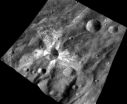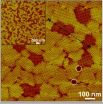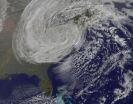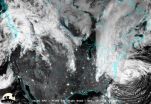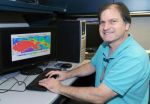(Press-News.org) PROVIDENCE, R.I. [Brown University] — The surface of the giant asteroid Vesta is weathering in a way that appears to be completely different from any other asteroid yet visited, according to new data recorded by NASA's Dawn spacecraft. This new type of space weathering suggests that there's something about Vesta — perhaps its mineral composition or its position in the solar system — that makes its surface environment fundamentally different from other asteroids studied thus far.
The new data are presented in a paper published Nov. 1, 2012, in the journal Nature.
Space weathering is the term used to describe how the surfaces of airless bodies like asteroids and some moons change over time. The phenomenon was first identified on our own Moon. Soil ejected from fresh impact craters looks brighter than the surrounding background soil, often forming bright rays streaming away from the crater. It wasn't clear at first why newly exposed soil would look different.
As laboratory equipment improved, scientists eventually showed that soils darken over time on the lunar surface because they are exposed to a constant barrage of tiny meteorites as well as energetic particles from the sun known as the solar wind. As these materials interact with the surface, they produce a fine coating of metal nanoparticles that builds up on soil grains over time, darkening the soil. Deeply buried material lacks that coating, so when it's churned up by a large meteorite impact, it has a brighter appearance than the weathered soil.
This same type of space weathering involving metal nanoparticles was later found to occur on several asteroids as well.
"We thought we understood this pretty well," said Brown University geologist Carle Pieters, one of the original scientists to study the phenomenon. "That's space weathering." Or at least it was until the Dawn spacecraft showed that Vesta, one of the largest bodies in the asteroid belt, weathers in a completely different way.
As on the Moon, soil ejected from craters on Vesta looks different from background soil, so it's clear that some kind of weathering is taking place on Vesta. But using Dawn's visible and infrared spectrometer, Pieters and colleagues found that weathered soil on Vesta doesn't have any of the nanophase metal that characterizes weathered soil on the Moon and some asteroids.
"We know that the surface of Vesta is weathering," Pieters said, "but it can't be happening in the same way as these other bodies."
Weathering on Vesta appears to happen through meteorite impacts that mix soils mechanically, not through creation of the nanophase metals like on the Moon. "Think of it like throwing a rock in a sandbox," Pieters said. "You're not altering the sand in any fundamental way. You're just tossing it around."
The trick now is figuring out why the nanophase weathering so pervasive on the Moon doesn't seem to happen on Vesta. One possibility is that the meteorites hitting Vesta don't vaporize as they often do on the Moon, or perhaps the solar wind is too weak out in the asteroid belt, making the formation of nanoparticles less likely, Pieters said. The prevalence of mechanical mixing could have something to do with how the gravitational characteristics of Vesta allows particles to move or with Vesta's initial mineral composition.
"It could be a lot of things," Pieters said. "That's the next problem we're working on now."
Pieters also plans to go back and re-examine space weathering processes on the Moon and other asteroids.
"There are probably things we've overlooked on other asteroids because we've just been concentrating on the nanophase coatings," she said. "But Vesta has shown us that this mixing process is really very important."
INFORMATION:
Dawn's mission is managed by the Jet Propulsion Laboratory for NASA's Science Mission Directorate in Washington. Dawn is a project of the directorate's Discovery Program, managed by NASA's Marshall Space Flight Center in Huntsville, Ala. UCLA is responsible for overall Dawn mission science. Orbital Sciences Corp. in Dulles, Va., designed and built the spacecraft. The German Aerospace Center, the Max Planck Institute for Solar System Research, the Italian Space Agency, and the Italian National Astrophysical Institute are international partners on the mission team.
New type of 'space weathering' observed on asteroid Vesta
2012-11-01
ELSE PRESS RELEASES FROM THIS DATE:
Taming mavericks: Stanford researchers use synthetic magnetism to control light
2012-11-01
Magnetically speaking, photons are the mavericks of the engineering world. Lacking electrical charge, they are free to run even in the most intense magnetic fields. But all that may soon change. In a paper published in Nature Photonics, an interdisciplinary team from Stanford University reports that it has created a device that tames the flow of photons with synthetic magnetism.
The process breaks a key law of physics known as the time-reversal symmetry of light and could yield an entirely new class of devices that use light instead of electricity for applications ranging ...
OHSU researchers discover potential way to repair brain damage in multiple sclerosis
2012-11-01
PORTLAND, Ore. — Researchers at Oregon Health & Science University have discovered that blocking a certain enzyme in the brain can help repair the brain damage associated with multiple sclerosis and a range of other neurological disorders.
The discovery could have major implications for multiple sclerosis, complications from premature birth and other disorders and diseases caused by demyelination – a process where the insulation-like sheath surrounding nerve cells in the brain becomes damaged or destroyed. Demyelination disrupts the ability of nerve cells to communicate ...
Spot the difference
2012-11-01
The 1000 Genomes Project today presents a map of normal human genetic variation – everything from tiny changes in the genetic code to major alterations in our chromosomes. In a DNA version of 'spot-the-difference', EMBL scientists and their colleagues studied the genomes of 1092 healthy people from Europe, the Americas and East Asia, systematically tracking what makes us different from each other. Their results, published in Nature, open new approaches for research on the genetic causes of disease.
"The 1000 Genomes Project has achieved something truly exceptional in ...
New study shows effects of prehistoric nocturnal life on mammalian vision
2012-11-01
AUSTIN, Texas — Since the age of dinosaurs, most species of day-active mammals have retained the imprint of nocturnal life in their eye structures. Humans and other anthropoid primates, such as monkeys and apes, are the only groups that deviate from this pattern, according to a new study from The University of Texas at Austin and Midwestern University.
The findings, published in a forthcoming issue of Proceedings of the Royal Society B, are the first to provide a large-scale body of evidence for the "nocturnal bottleneck theory," which suggests that mammalian sensory ...
Jamaican teen immigrants do better when they retain strong ties to original culture
2012-11-01
URBANA –Many young Jamaican immigrants are succeeding in the United States precisely because they remain strongly tied to Jamaican culture, said University of Illinois professor Gail M. Ferguson.
"Although many of these youths have forged a unique tricultural identity that draws from their Jamaican culture, African-American culture, and mainstream European American culture, the important factor in their academic and behavioral success is retaining strong ties to their Jamaican background," she said.
To learn how Jamaican immigrant teens were adjusting to life in their ...
Folding funnels key to biomimicry
2012-11-01
Proteins are able to self-assemble into a wide range of highly ordered structures that feature a diverse array of properties. Through biomimicry - technological innovation inspired by nature – humans hope to emulate proteins and produce our own version of self-assembling molecules. A key to accomplishing this is understanding how protein-folding – a process critical to the form and function of a protein – is extended from individual proteins to complex assemblies.
Researchers with the U.S. Department of Energy (DOE)'s Lawrence Berkeley National Laboratory (Berkeley Lab) ...
Satellite captures the life and death of Hurricane Sandy on Halloween
2012-11-01
VIDEO:
This animation of satellite imagery shows the life of Hurricane Sandy from its development in the Caribbean Sea on Oct. 21, through its track up the US East coast and...
Click here for more information.
Hurricane Sandy is giving up the ghost on Halloween over Penn. As the storm weakened to a remnant low pressure area the NASA GOES Project released an animation of NOAA's GOES-13 satellite imagery covering Hurricane Sandy's entire life.
The GOES-13 satellite is managed ...
NASA/NOAA's Suomi NPP captures night-time view of Sandy's landfall
2012-11-01
As Hurricane Sandy made a historic landfall on the New Jersey coast during the night of Oct. 29, the Visible Infrared Imaging Radiometer Suite (VIIRS) on NASA/NOAA's Suomi National Polar-orbiting Partnership (NPP) satellite captured this night-time view of the storm. This image provided by University of Wisconsin-Madison is a composite of several satellite passes over North America taken 16 to18 hours before Sandy's landfall.
The storm was captured by a special "day-night band," which detects light in a range of wavelengths from green to near-infrared and uses filtering ...
Dust's warming counters half of its cooling effect
2012-11-01
The mineral properties of the aerosol particles and the wavelength distribution of incident light combine to determine whether a dust particle reflects radiation and cools the local atmosphere, absorbs radiation and warms the local atmosphere, or both. While scientists have a good handle on dust's primary effect of reflecting and cooling at the visible wavelengths, the smaller influence of absorbing and warming at the longer infrared wavelengths has remained more of an uncertainty – and most climate models either underestimate it or do not include it at all.
When the ...
More evidence needed to support use of autism interventions
2012-11-01
Interventions designed to improve core deficits in children with autism spectrum disorders are supported by varying levels of evidence, highlighting the need for well-designed studies to better evaluate the interventions, according to a new RAND Corporation study.
Researchers found that when they evaluated the past research on a wide variety of interventions aimed at improving core deficits in social/communication, language, behavior and adaptive skills, the evidence of efficacy ranged from moderate to insufficient. The findings are published in the November edition of ...
